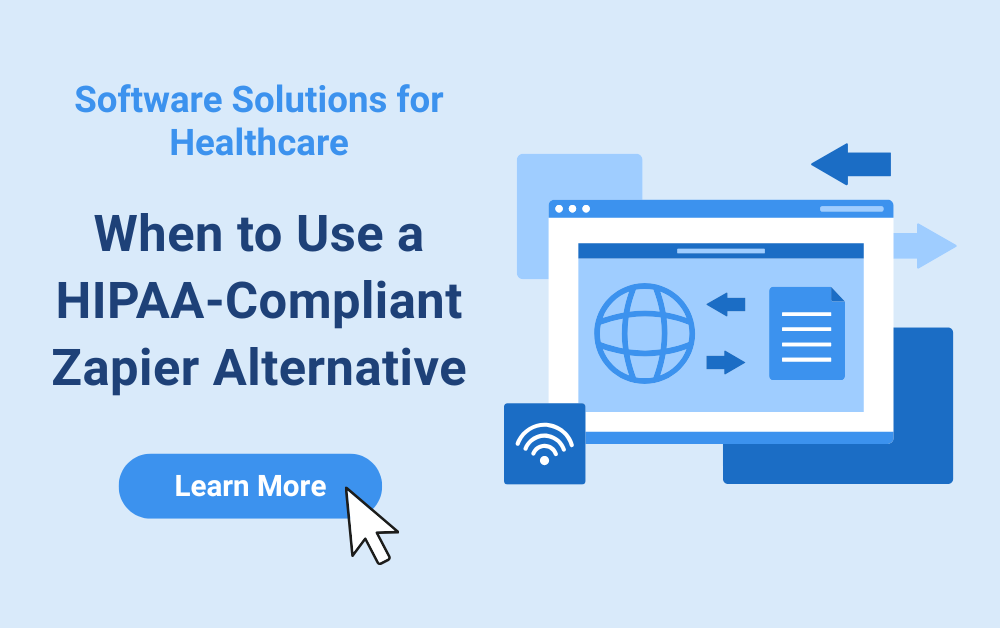When to Use a HIPAA-Compliant Zapier Alternative
October 15, 2025

Last updated on: October 14, 2025
Automation tools like Zapier have revolutionized how organizations streamline workflows. But for healthcare businesses that handle protected health information (PHI), Zapier isn’t an option because it lacks HIPAA-compliance. That’s why finding a HIPAA-compliant Zapier alternative is essential.
Below, we’ll cover what Zapier is used for, when to reach for secure Zapier-like tools to meet HIPAA-compliance, and what tech options (like Keragon) are a vailable for healthcare organizations looking to automate safely and efficiently.
What is Zapier Used For?
Quick Answer: Zapier helps businesses automate repetitive workflows by connecting thousands of apps - no coding required.
Zapier is a powerful tool that allows non-technical people to create sophisticated automations and connect 6,000+ supported integrations. The power of letting any person connect and automate the tools their business relies on, especially without needing coding experience, cannot be understated.
In practice, teams can use Zapier to create automated workflows that transmit data through something like form submissions → spreadsheets → Slack alerts → task creation → email follow-ups. Think of it as like a domino effect; once the initial step is triggered, the rest will follow.
For healthcare organizations, you can create similar workflows to enhance patient management and create a streamlined experience: patient intake form → EHR updates → care-team notifications → patient scheduling link. But if any step contains PHI, you must use a secure, HIPAA-compliant tool to transmit that data.
Is Zapier HIPAA-Compliant?
Quick Answer: Zapier does not meet HIPAA requirements and does not sign BAAs, making it unsuitable for workflows involving PHI.
While Zapier offers secure integrations for general business operations, it explicitly states that it does not sign a Business Associate Agreement (BAA) and is not HIPAA-compliant.
The HIPAA Journal reports that 32% of healthcare data breaches stem from third-party integrations and cloud applications that lack proper compliance safeguards. Using non-compliant automation tools like Zapier can therefore expose organizations to costly risks. HIPAA violation fines can reach $1.5 million per year for repeat offenders.
When to Use Zapier-like HIPAA-Compliant Tools
Quick Answer: Choose a HIPAA-first automation platform when an all-in-one solution won’t cover everything, you need multiple tools to integrate without heavy engineering, or custom one-off builds can’t orchestrate automations across your stack.
- When an all-in-one solution won’t cover everything: If you can’t find a single platform that delivers most of what you need, add a secure automation layer to bridge the gaps between tools.
- When you’ll use multiple tools and need them to talk: If you’ve confirmed you’ll rely on several systems and they must be integrated (but you don’t want to spend engineering time on custom APIs), a HIPAA-first automation platform is the practical choice.
- When custom, one-off integrations fall short: Even if you hire someone to build a bespoke connection, it may not orchestrate automations across all your other apps. That’s where a Zapier-like HIPAA-compliant tool can come in handy.
Even though these tools require vetting and setup, why does this approach pay off? According to a 2024 Deloitte Digital Health Survey, healthcare organizations that implemented compliant automation tools saw a 32% increase in workflow efficiency and a 25% reduction in administrative costs. This is proof that compliant automation removes real cost and friction for healthcare teams.
HIPAA-Compliant Zapier Alternatives
Quick Answer: Keragon is a noteworthy HIPAA-compliant Zapier alternative - offering secure automation, a signed BAA, and direct integrations with all-in-one solutions like Tellescope.
Since automated workflows are becoming an essential part of digital health operations, that’s where tools like Keragon come in. Keragon is a HIPAA-compliant workflow automation tool built specifically for healthcare and life sciences organizations. It allows users to connect tools and automate processes securely, offering encryption, audit trails, and signed BAAs.
Key Features:
- Signed BAA to ensure full HIPAA compliance
- End-to-end encryption for data in transit and at rest
- Comprehensive audit logs for compliance tracking
- Prebuilt healthcare integrations for EHRs, CRMs, and patient communication tools
- No-code workflow builder for non-technical users
Keragon has also partnered with Tellescope, an all-in-one platform that unifies everything you need in your healthcare tech stack. Together, Tellescope and Keragon provide healthcare organizations with seamless, secure automation that enhances care coordination and reduces manual tasks.
For example, healthcare teams can use Keragon to combine Tellescope patient engagement data with EMR, billing, and marketing data stored in Snowflake to build predictive models. This allows teams to identify at-risk patients, forecast care needs, or optimize outreach programs based on a 360° view of the patient journey across systems. No more manual tracking or updating clunky spreadsheets.
When to Use an All-in-One Solution Rather Than Connecting Multiple Tools
Quick Answer: Choose an all-in-one solution like Tellescope when your goal is to unify patient experience, streamline workflows, and reduce tool fragmentation across teams.
While connecting multiple tools is useful, healthcare organizations often benefit more from an all-in-one platform that consolidates critical operations in one place. Constantly switching between fragmented tools increases the risk of data loss and miscommunication. But more often than not, it impacts operations via loss of time and efficiency.
Tellescope solves this by bringing everything under one secure, HIPAA-compliant roof; online forms, patient communication, scheduling, telehealth, charting, internal messaging, file storage, etc. Within Tellescope, you can even create no-code triggers and automations using built-in features.
But if you need external orchestration for PHI-safe integrations, Tellescope’s partnership with Keragon gives you the best of both worlds - unified care operations with compliant cross-app automation.
By adopting an all-in-one approach, healthcare organizations save time, reduce tech costs, and strengthen compliance. Join teams like Fella Health that are simplifying care delivery with Tellescope. If you’re ready to simplify and scale your patient experience, book a demo to see Tellescope in action.
Originally published: October 18, 2023
Last updated: October 15, 2025